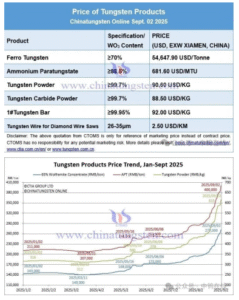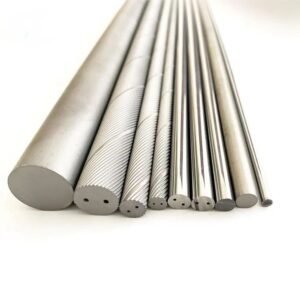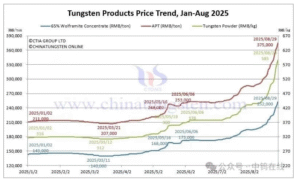Tungsten carbide inserts are essential cutting tools in modern machining, offering superior hardness, wear resistance, and durability. Their manufacturing process is highly precise, involving multiple stages to ensure the final product meets the high-performance standards required in industries like aerospace, automotive, and mold manufacturing. In this article, we will explore each step of the tungsten carbide insert manufacturing process in detail, highlighting how raw materials are transformed into high-precision cutting tools.
1. Raw Material Selection and Preparation
The manufacturing process begins with the selection of high-purity raw materials. Tungsten carbide (WC) powder is the primary component, known for its exceptional hardness. However, pure tungsten carbide is brittle and lacks toughness. To improve its mechanical properties, it is combined with a metallic binder, usually cobalt (Co) or nickel (Ni), which enhances toughness while maintaining hardness.
At this stage, other elements, such as tantalum carbide (TaC), titanium carbide (TiC), and niobium carbide (NbC), may also be added to improve wear resistance, thermal stability, or oxidation resistance, depending on the specific application of the insert.
2. Powder Mixing and Milling
Once the raw materials are selected, they must be thoroughly mixed to achieve a uniform particle distribution. This is done using ball milling or attritor milling, where tungsten carbide powder, the binder metal, and any additional additives are combined in a liquid medium (often alcohol or water) with milling balls.
The purpose of this step is to:
- Ensure homogeneous distribution of the carbide and binder particles.
- Reduce particle size to enhance material properties.
- Improve the compacting ability of the powder for later stages.
This process can take several hours or even days, depending on the desired particle size and material composition.
3. Spray Drying and Granulation
After mixing, the slurry is passed through a spray drying system, where it is dried into granulated powder. The resulting granules have a uniform particle size, which is essential for achieving consistent density during pressing.
At this point, the powder is ready for shaping, with an optimized flowability that ensures even distribution during the compacting process.
4. Pressing – Forming the Insert Shape
The granulated powder is then pressed into the desired shape using specialized pressing techniques:
Cold Pressing
- Used for high-volume production.
- Powder is placed into a die and compressed using mechanical or hydraulic pressure.
- This method is suitable for producing standard insert shapes like CNMG, DNMG, and SNMG.
Isostatic Pressing
- Used for producing inserts with more uniform density.
- Pressure is applied evenly from all directions, reducing the risk of internal defects.
- Preferred for complex shapes or large inserts requiring high strength.
At this stage, the pressed insert, known as a "green compact", is fragile and must be handled carefully before further processing.
5. Sintering – The Key to Strength and Hardness
Sintering is the most critical step in carbide insert manufacturing, where the pressed powder is subjected to extremely high temperatures (1,300–1,600°C) in a controlled atmosphere furnace. During this process:
- The binder metal melts, allowing the tungsten carbide particles to bond together.
- The insert shrinks by approximately 20–30%, becoming dense and hard.
- The final microstructure forms, giving the insert its unique balance of hardness and toughness.
Advanced sintering techniques, such as hot isostatic pressing (HIP), can further improve insert strength by eliminating internal porosity, ensuring a more uniform and durable final product.
6. Precision Grinding and Edge Finishing
After sintering, the carbide insert is hard but not yet precise. To meet strict dimensional tolerances, the inserts go through precision grinding and finishing:
Diamond Grinding
Since tungsten carbide is extremely hard, traditional grinding methods are ineffective. Instead, diamond grinding wheels are used to achieve precise dimensions and edge sharpness.
Edge Honing & Lapping
- Edge honing improves tool performance by smoothing out micro-defects.
- Lapping enhances surface quality, reducing friction and improving cutting efficiency.
At this stage, the insert is functionally complete but may receive an additional treatment to improve performance—coating.
7. Coating – Enhancing Performance
To further enhance the durability and efficiency of carbide inserts, many undergo a CVD (Chemical Vapor Deposition) or PVD (Physical Vapor Deposition) coating.
CVD Coating (Chemical Vapor Deposition)
- Applied at high temperatures (900–1,100°C).
- Creates a thick, wear-resistant coating.
- Common coatings include Titanium Nitride (TiN), Titanium Aluminum Nitride (TiAlN), and Aluminum Oxide (Al₂O₃).
PVD Coating (Physical Vapor Deposition)
- Applied at lower temperatures (400–600°C).
- Produces a thinner, harder, and more adhesion-resistant coating.
- Ideal for high-speed machining applications.
These coatings significantly improve wear resistance, heat resistance, and cutting performance, extending the tool’s lifespan.
8. Quality Inspection and Packaging
Before shipment, carbide inserts undergo strict quality control checks, including:
✅ Dimensional Accuracy Testing – Ensuring size and shape meet exact specifications.
✅ Hardness & Toughness Testing – Verifying the material’s mechanical properties.
✅ Coating Inspection – Checking for uniformity and adhesion.
Only inserts that pass these stringent tests are packaged and shipped to customers worldwide for use in turning, milling, drilling, and grooving applications.
Conclusion
The manufacturing of tungsten carbide inserts is a highly precise and technical process, requiring advanced engineering and strict quality control. From raw material selection to sintering, grinding, and coating, each step is crucial in ensuring that the final product offers superior hardness, wear resistance, and machining efficiency.
As industries demand higher productivity and precision, innovations in carbide insert manufacturing continue to push the boundaries of performance, making these tools indispensable in modern machining.
Would you like recommendations on the best tungsten carbide inserts for your specific application? Feel free to reach out!





